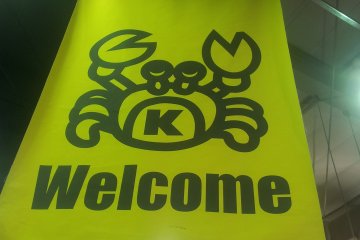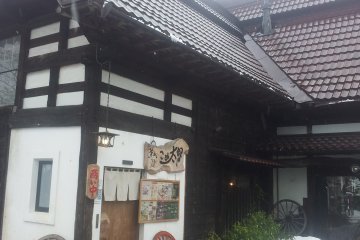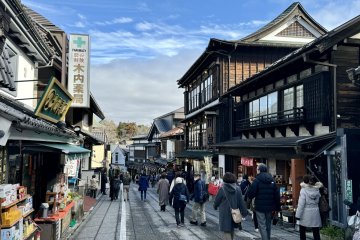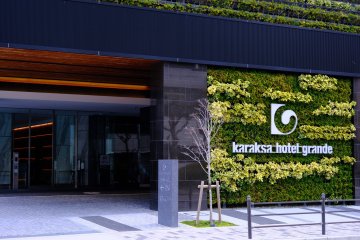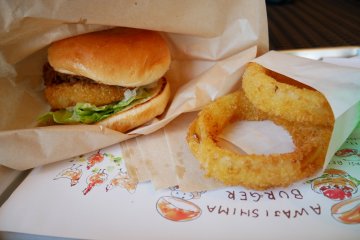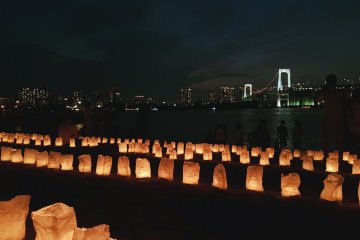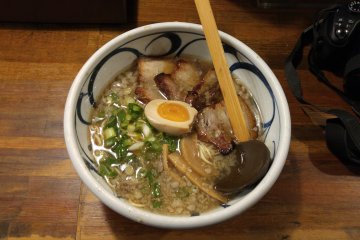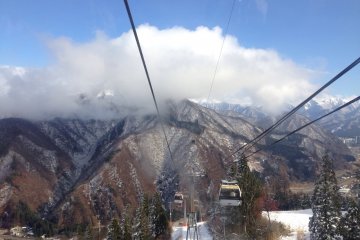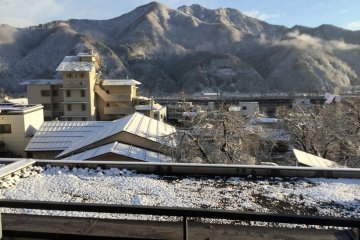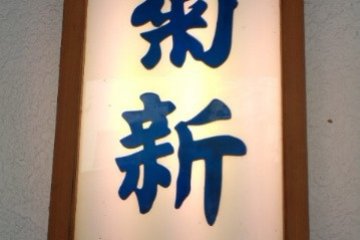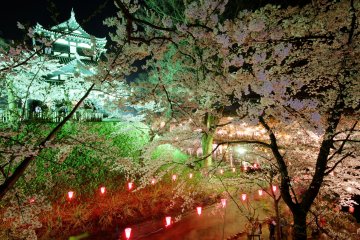Although the Echigo-Tsumari Triennale only happens once in three years, the Echigo-Tsumari region in Niigata also holds events like the annual winter Echigo-Tsumari Art Field 2019 Winter “SNOWART” and Daichi-no-matsuri (summer festival) which takes place in the years between the Triennale. With major art events happening every year, Echigo-Tsumari is kept bustling and lively!

While variety is always welcomed, the wealth of things to do and see in Echigo-Tsumari may leave you overwhelmed, not knowing where to start or which pieces to prioritize when you’re short on time. The following list helps you out by highlighting the places and experiences not to be missed there during winter!
Echigo-Tsumari Satoyama Museum of Contemporary Art, KINARE
Number one on the list is none other than the Echigo-Tsumari Satoyama Museum of Contemporary Art, KINARE. The museum houses a collection of works that are centralized around nature and people, and the interaction between them.
The term "satoyama" in the museum's name refers to the environment the locals live in. Living in a mountainous region that sees harsh winters and heavily reliant on agriculture, the people of Echigo-Tsumari have an intimate relationship with nature. The co-existence of these two entities is encompassed in “satoyama” which means “village” and “mountain”, referring to to the plots of land between mountain sides and arable farmland where people live and till the land.

At the museum, visitors get to experience various artworks like “Ghost Satellites”, a colorful and imaginative installation made by putting together an assortment of old farming tools and household items collected from abandoned houses and donated by residents. The hanging sculptures made from objects like spoons, rattan chairs, badminton rackets and screen doors are great fun to look at.

Another fascinating piece is “Tunnel”, a semi-cylindrical shed that is commonly spotted alongside the locals’ houses. These sheds have curved roofs to distribute the heavy snowfall during winter and are used to store tools and shelter cars. Standing before the “Tunnel”, it looks inconspicuous but stepping into it gives a pleasant surprise. The shed replica transforms into a mountain tunnel framed with greenery and a van before you and the sounds of cicadas chirping in your ears. If you’re too entranced to notice, you might just hit your head before realizing the tunnel tapers off!
Upon first glance, “Fuyu” is just a large glass box filled with countless pieces of glitter confetti. Or so you thought. If you squint and look harder, you’ll be able to make out the silver confetti is actually cut-outs of tiny houses reminiscent of those you see on the streets around Echigo-Tsumari. When the vents of the glass case are activated, the little pieces of houses would be blown into a chaotic whirlwind. It’s meant to make viewer reflect on the devastating damages and loss suffered by the local community when it was struck by earthquakes like the Chuetsu Earthquake in 2014.
It's recommended to join a tour when you visit the museum as it’ll provide a lot more insight into the artworks and environment. Apart from the exhibits mentioned above, the museum has many more thought-provoking installations to explore. It also features a cafe, souvenir shop, and a playground slide to entertain the young visitors. As the hub of the triennale and heart of art in Echigo-Tsumari, the Echigo-Tsumari Satoyama Museum of Contemporary Art, KINARE is not to be missed.
Matsudai History Museum, Yukimigozen
Built at the end of Edo, the 140-year-old “Keyaki Minka” is a traditional Japanese house constructed with zelkova timber and 10 meter tall columns to support the house through heavy snowfall. The preserved house which has since been converted to a local museum, featuring a hearth, a tea room, a guest room and a tatami room. It also displays local farming tools information on Matsuo Shrine, a national treasure, and plays footage of the region’s terraced rice fields.

However, there’s more to the museum than archives and artefacts and that is - Yukimigozen! Entering the tatami room, one would see little red and black lacquer tray tables that are topped with a variety of small dishes set around the room. Yumikigozen is a meal offered only to winter tour participants. The lucky ones get to savor homemade dishes prepared and served by the lovely locals who are mainly headscarf-wearing obaachan (grandmothers) decked out in aprons.

Before the feast begins, everybody’s cups are filled with sake - especially good as Niigata grows premium rice. A toast is raised, the whole room rings out in “kanpai!” and the feast begins. Dig into dishes such as chewy konjac jelly coated with a creamy sesame sauce, pickled lettuce and pumpkin, a plate of assorted fresh vegetables, roasted potatoes, candied sweet potatoes and a savory chunk of fish adorned with ginkgo nuts and a piece of petal-shaped fishcake.

As you’re enjoying your meal, the obaachan will go round the room, armed with a platter of a new dish or a sake bottle each, adding to your already-full table and urging you to eat more - just like your grandmother would.

If warm human connection is what you seek, it’s what you’ll get here at the Matsudai History Museum! The Yumikigozen is a great choice for people who are seeking a taste of authentic Japanese mountain cuisine and a heartwarming experience.
Gift for Frozen Village 2019
If visual spectacles are what you’re after, look no further than the annual “Gift for Frozen Village”, a firework extravaganza set on snowy slopes adorned with clusters of bright, colorful LED lights totaling up to 35,000 bulbs.

The fireworks display is designed by Takahashi Kyota who is renowned for his light installations. Regarded as the highlight of the “Snow Art Project”, the fireworks show is bound to be a treat!

Before the show begins, fuel up for the cold with the finger food, beer and even ramen or udon at the winter food market at the bottom of the slopes. Desserts like fried baumkuchen drizzled with caramel sauce, dusted with powdered sugar and topped with almond flakes are great too! If you want to secure seats within the tentage, do come early to beat the crowd. That, or you can follow the enterprising Japanese who bring their own camping chairs.
Stepping onto the slope, it would feel as though you’ve been teleported into a children’s storybook. Looking around, you’d notice just about everyone else are transfixed by the enticingly glowing bulbs in the snow. The vibrant seeds of light juxtaposed against the dull snowy landscape after dark sure felt alienesque yet pleasant. As the fireworks begin, the spectators’ attention is shifted from the snow skywards to the beautifully designed hanabi (fireworks or “fire flowers” literally).

"Ooh's" and “Ah’s” ring out simultaneously as the first burst of light exploded onto the night sky, accompanied by upbeat dance music. The spectacle goes on for around 10 to 15 minutes, treating viewers to a marvelous hanabi experience on snow.

The “Gift for Frozen Village 2019” had just been held on March 2, 2019, making it the ninth edition of the fireworks display. Don’t be too disappointed as you can always experience it the next winter!
Tunnel of Light by Ma Yansong
Named one of the top gorges in Japan, Kiyotsu gorge is spectacular with its hexagonal volcanic rock columns and clear blue water flowing below. While its natural beauty is already astounding, its charm is further accentuated by the Tunnel of Light.

Situated in the 750-meter long Kiyotsu Gorge Tunnel, the Tunnel of Light features light and sculptural installations by renowned Chinese architect, Ma Yansong. Walking through the tunnel, visitors are treated to sections of the tunnel that are adorned with vibrant colored lights from cool greens and blues to warm oranges and pinks while mysterious and eccentric music reverberate off the walls. Walking along the semi-dark tunnel with the music and lights, one’s senses and anticipation are aroused.

Apart from the lights, the tunnel also features four viewing points, most with art installations. These viewing points allow natural light and ventilation into the tunnel while providing stunning vistas of the gorge.
The first viewing point is kept plain and simple, allowing visitors to take in a first undistracted view of the beautiful gorge.
Next, the second viewing point features the “Invisible Bubble”, a metallic standalone structure that serves as a toilet which allows users to look out onto their surroundings and the gorge while keeping those outside from looking in.
The third viewing point known as “The Drop” features convex metallic pieces backlit by a red glow which represent suspended droplets of dew. The fiery tones used here contrast strongly with the natural landscape that visitors see beyond the metallic red-ringed spots.

Lastly, at the end of the 750-meter long tunnel, visitors are rewarded for their effort and perseverance for making it to through the tunnel with the “Light Cave”. The last installation features a shallow pool of water spanning across the width of the viewing deck and a metallic reflective layer over the curving ceiling and walls. Together, these features create an expansive feel of the viewing chamber. Over here at the last station, because of the water and metallic features, the previous semi-circular viewing decks has become fully-rounded, reflecting views of the gorge and sky onto the circle, seemingly signifying wholeness as the journey comes to an end.

For light, installation art and nature lovers, the Tunnel of Light definitely makes a great choice!
Background and Birth of Echigo-Tsumari Triennale
Every three years, the Echigo-Tsumari Art Triennale takes place in Niigata during the warmer months between July to September. One of the largest art festivals around the globe, the Echigo-Tsumari Art Triennale features an interesting mix of Japanese and international artists and an ever-expanding repertoire of artwork. Inaugurated in 2000, the festival’s collection amasses with each triennale and currently stands at over 300 pieces.
Born of practical and pressing concerns, the art festival was started to revive the declining community of the Echigo-Tsumari region. Facing a harsh winter with heavy snowfall each year and the drain of its youth to larger cities, the ageing population of Echigo-Tsumari dwindles further. Coupled with the Chuetsu earthquake that struck the area in 2004, residents here were left struggling.

Started by the same man behind the Setouchi Triennale, the Echigo-Tsumari Triennale is directed by Fram Kitagawa. Born in Niigata, Kitagawa graduated from the Tokyo University of the Arts and has since dedicated his career to community development by revitalizing declining communities with art projects, exhibitions and festivals.
The large array of intriguing and meaningful artwork is dotted throughout the region, allowing visitors to take in sights of majestic mountains and local life as they travel around.

เส้นทาง
From Tokyo Station, take the JR Joetsu Shinkansen to Echigo-Yuzawa Station (1 h 20 min). Then, take the Hokuhoku Line to Tokamachi Station (35 min).
Traveling by car from Tokyo takes 3 hours.
Traveling by a highway bus takes 3 hours from the east exit of Ikebukuro Station in Tokyo to the Muikamachi I.C. bus stop. Then, continue on foot (30 min) or take a local bus (8 min) to Muikamachi Station.
Sarah Koh @sarah.koh
A Singaporean living in Tokyo, exploring Japan day by day.





